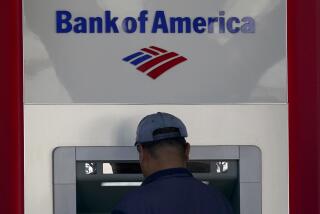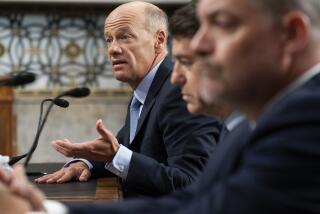B of A’s New President : Cooper Seen as Intense, Creative
- Share via
SAN FRANCISCO — Few bankers have followed more unlikely career paths than Thomas A. Cooper, who was named Monday as president and chief operating officer of the sprawling and troubled Bank of America.
The 49-year-old Cooper is an ordained Methodist minister who served two Pennsylvania churches before leaving the ministry for odd jobs driving trucks and painting houses.
“Ex-clerics weren’t exactly in high demand,” he noted wryly in an interview Wednesday, his first since his appointment was announced.
He got into banking by “knocking on doors,” hiring on as a trainee for an assistant branch manager’s slot at Philadelphia’s Girard Bank in 1962.
Those days are far behind him. He rose to the presidency of Girard, then became a vice chairman of Pittsburgh-based Mellon Bank after it acquired Girard in 1983. He left Mellon to become an executive vice president of Bank of America last year.
In picking Cooper to head up the bank’s day-to-day operations while Chairman and Chief Executive Samuel H. Armacost concentrates his time on setting policy, Bank of America’s board of directors passed over half a dozen bank officers with more tenure and breadth of experience.
Cooper “has all the qualities I would seek in a good operating officer,” said Armacost, who remains president and chief executive of BankAmerica, the bank’s holding company. In his 12 months as head of BankAmerica’s 11,000-employee payments division, Cooper “was able to reduce staff and costs while meeting all objectives,” Armacost said.
At Bank of America, he promises to emphasize customer service. “We have to present ourselves as meeting customers’ needs rather than as peddling products,” he said. Customers, he argues, will be willing to pay premium prices if they perceive the bank’s services as valuable.
“Generally speaking, bankers have not been very sophisticated about pricing,” he says. At Girard, Cooper charged customers $30 for each bounced check, though he said he is not likely to do the same thing here.
Cooper is a strong believer in participatory management. “He likes to stretch our minds,” said Frank Schultz, a senior vice president who reports directly to Cooper. “He’s always looking for new ideas, new approaches to solving problems.”
He will certainly have that opportunity at the bank, whose five-year slide in earnings culminated in a loss for BankAmerica in 1985 of $337 million, the third-largest annual deficit in U.S. banking history. Despite Armacost’s attempts to cut costs, the bank is widely viewed as over-staffed.
But Cooper takes exception to the suggestion that he will use his new mandate to ruthlessly cut costs.
“People like myself can get a very macho image by talking about layoffs,” he said.
Instead, he speaks of “getting associates”--defined as everyone from tellers to executive vice presidents--”involved in the planning process.”
“The more you get your associates involved in a plan, the less supervision they need, the less management you need.”
Cooper drives himself--and his employees--hard. Typically, he’ll get to work around 7 a.m. and put in 12 to 14 hours before going home.
“You can’t get ahead of him,” said Richard Morrison, president of BA Cheque Corp., a BankAmerica subsidiary. “Say you’ve finished a big project and you think you’ve got a few days of breathing space. Forget it. He bounces it back to you like a rubber ball.”
Vinton Baker, a senior vice president, added: “He’s the most creative individual I’ve ever worked with. Anytime you tell him you’ve got a solution to something, he’ll give you five more.”
Although he stressed new technologies such as automated teller machines and telephone banking while at Girard and is likely to do the same at Bank of America, Cooper understands that “even the most committed devotee of electronic banking sometimes needs a human interface. Our goal is to make that interface as satisfying as possible.”
In the California retail market, Cooper said, Bank of America’s real competition does not come from other big banks, such as Security Pacific, Wells Fargo and First Interstate. Rather, he said, it is the thrifts, credit unions, small “boutique” banks and out-of-state bank-by-mail operations that have been enjoying the most growth in recent years.
“We have to operate better than them,” he said.
He said he is confident that Bank of America’s tarnished reputation will improve “shortly” as the bank returns to profitability. “I’m more bullish than a lot of (securities) analysts.”
He is also loyal to Armacost, who, he said, sets the bank’s strategy and policy. “It’s my job to implement the plan against the standards and goals that he sets.”
Times staff writer John M. Broder in Los Angeles contributed to this story.
More to Read
Inside the business of entertainment
The Wide Shot brings you news, analysis and insights on everything from streaming wars to production — and what it all means for the future.
You may occasionally receive promotional content from the Los Angeles Times.










